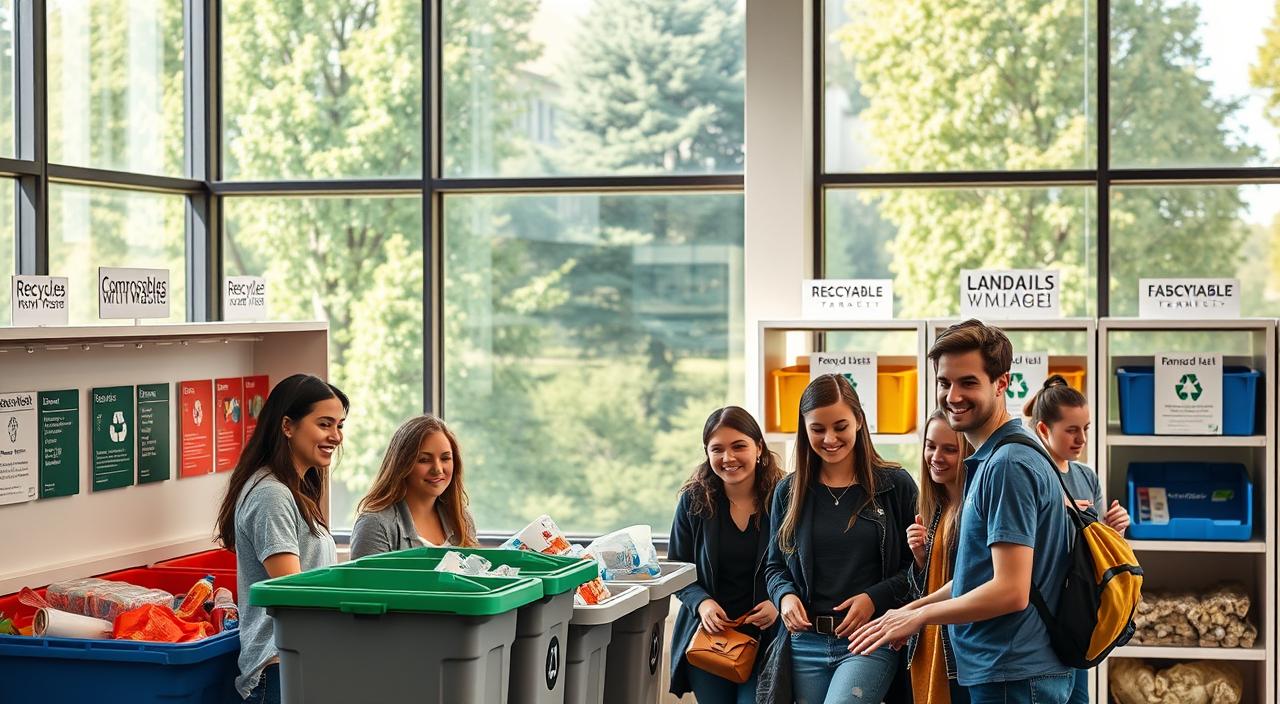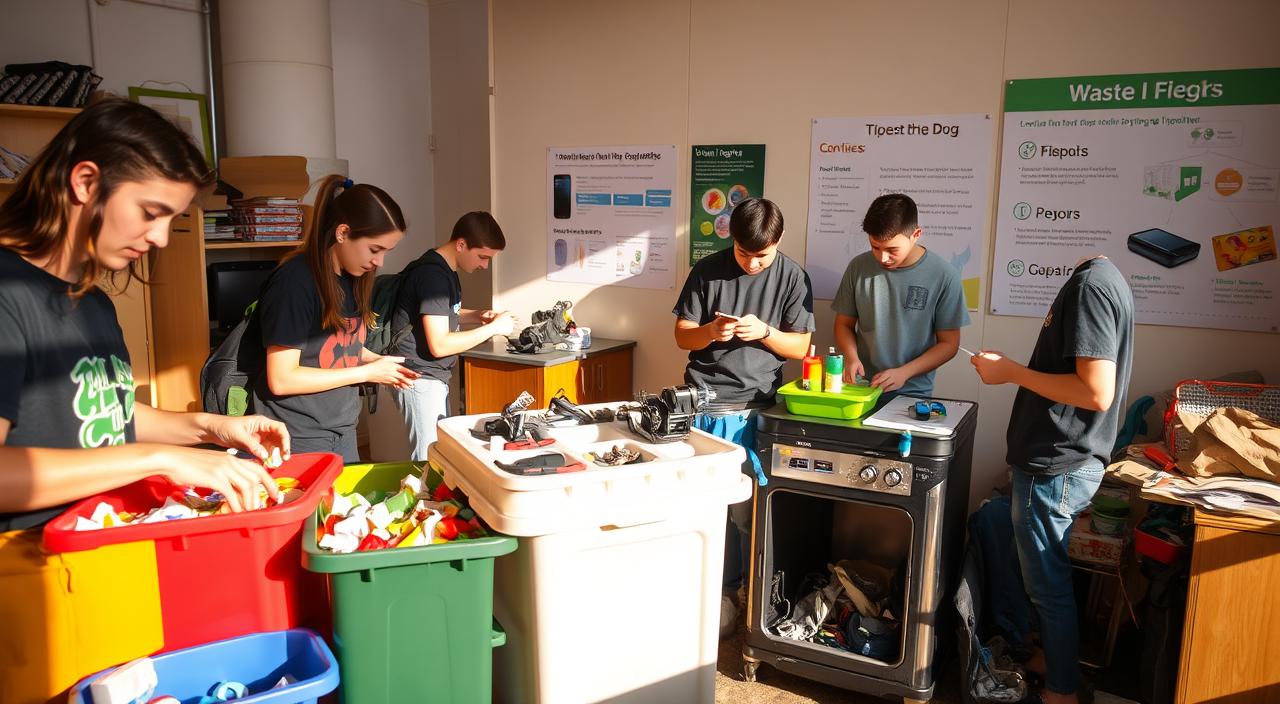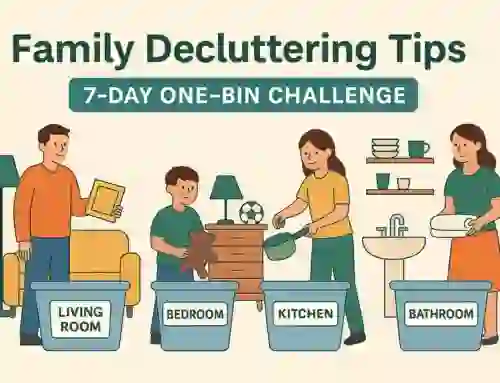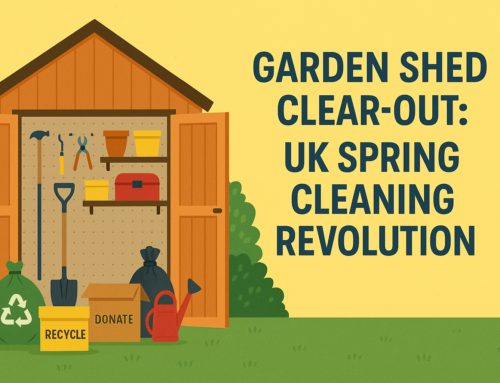University student housing waste is a growing challenge across the UK. Each academic year brings predictable rubbish surges as students move in, study through exam season, and eventually clear out at the end of term. From piles of packaging to abandoned furniture, these peaks can overwhelm collection systems, frustrate neighbours, and harm the environment if not carefully managed.

This guide explores why rubbish surges in student accommodation, how to design effective recycling systems, and practical solutions for bulky items that appear at the end of term. By adopting better waste management, universities, landlords and students can keep living spaces clean, reduce landfill, and avoid fly-tipping penalties.
Key Takeaways
- Plan ahead for peak waste periods at move-in, exam season, and move-out.
- Provide general, recycling and food bins with clear, multilingual signage.
- Scale collection frequency and bin sizes to match occupancy and term cycles.
- Offer donation and recycling routes for bulky items like furniture and bedding.
- Encourage small daily habits that reduce waste and keep communal spaces tidy.
Why University Student Housing Waste Peaks Across the Academic Year
Unlike typical households, student properties face unusual spikes in rubbish. Three distinct periods drive the annual surge:
- Move-in (September/October) – Students arrive with packaging, new bedding, and kitchen items. Large amounts of cardboard, plastic wrapping and delivery boxes pile up.
- Mid-term (exam and social season) – Food packaging, bottles and cans increase as stress and social gatherings peak.
- Move-out (June/July) – The biggest spike occurs as tenants leave, often discarding large volumes of furniture, electronics, clothing and bedding.
Without careful planning, these waves can overwhelm normal collection systems, leading to overflowing bins and neighbourhood complaints.
The End-of-Year Clear-Out and Its Impact on University Accommodation
At the close of each academic year, corridors and car parks fill with sofas, broken appliances, duvets, and unwanted clothes. This “waste mountain” is preventable when alternative disposal routes are promoted early.
- Reusable goods: Charity shops often accept pots, pans, small appliances and furniture if arranged in advance.
- Textiles: Duvets and pillows should be taken to textile banks or animal charities.
- Electronics: Household Waste Recycling Centres (HWRCs) and retailer take-back schemes are the right option for laptops, chargers and kettles.
- Books and food: Course books can be sold or passed on, while unopened tins and packets should go to food banks.
Simple checklists shared with students in May can dramatically reduce last-minute dumping.
Environmental and Neighbourhood Impacts of Poor Disposal
Poorly managed student waste causes problems that go far beyond an untidy kitchen:
- Overflowing bins attract pests and create foul odours.
- Contaminated recycling (e.g., food mixed with plastics) turns whole collections into landfill.
- Fly-tipping fines can fall on landlords or accommodation managers if rubbish piles up outdoors.
- Neighbour relations suffer when pavements are blocked with unwanted furniture.
Respectful, well-planned disposal not only protects the environment but also builds a stronger reputation for accommodation providers.
Building an Efficient University Student Housing Waste System
The first step in tackling university student housing waste is to design a system that works throughout the year.
Essentials of a Good Setup
- Bin stations at source – Kitchens and lobbies should have clear separation for general waste, mixed recycling, and food waste.
- Glass recycling – In student housing with regular parties, a dedicated container for bottles and jars prevents contamination.
- Multilingual signage – Many students are international; clear icons, colours and translations prevent confusion.
- Routine checks – Weekly walk-throughs by managers spot issues before they escalate.

Table 1: Recommended Bin Sizes and Collections
| Bin Type | Typical Items | Sizing Advice | Collection Frequency |
|---|---|---|---|
| General waste | Hygiene items, non-recyclable packaging | 80–120L per 6–8 residents | Weekly; more at peak times |
| Dry recycling | Paper, card, plastics, cans | 120L per 8–10 residents | Weekly to twice-weekly |
| Food waste | Scraps, coffee grounds | 40–60L per kitchen + counter caddies | 2–3 times weekly |
| Glass | Bottles, jars | 240L shared container or lockable hopper | Weekly or fortnightly |
Setting Up a Practical Recycling System for Student Housing
A recycling system only succeeds if it is easy to use and consistent across the building.
Choosing the Right Bins
- Large halls need bigger communal containers, while small flats benefit from compact tubs.
- Always include separate bins for general, recycling and food waste.
- Provide spare liners and kitchen caddies for organics.
Labelling and Visual Aids
- Colour-coding and symbols should be consistent throughout the property.
- A “what goes where” checklist above each station simplifies choices.
- Keep the language short and clear for multilingual audiences.
Bin Placement
Place bins where waste is created:
- Kitchens (general, recycling, food caddy)
- Lobbies and entrances (large recycling bins)
- Common rooms (small recycling and general bins)
- Landings (mini food caddies with spare liners)
Table 2: Smart Bin Placement
| Location | Recommended Bins | Notes |
|---|---|---|
| Kitchen | General, recycling, food caddy | Counter caddy prevents odours and pests |
| Lobby/Entrance | Large recycling, general | High-traffic; ideal for bottles and packaging |
| Common room/Study | Small recycling, general | Supports late-night study sessions |
| Floor landing | Small food caddy + liners | Makes organics disposal convenient |
Reducing Waste Day to Day in University Accommodation

Students can make a difference with small, sustainable habits.
- Plan and share meals – reduces food spoilage.
- Keep a counter food caddy – empty regularly into the main bin.
- Print less – use online submissions and recycled notebooks.
- Rinse packaging – keeps recycling streams usable.
- Reuse and donate – set up a communal shelf for unwanted items.
Apps like Too Good To Go help reduce food waste by letting students buy surplus meals from shops at a discount.
Handling Bulky and Special Items in Student Housing
When it’s time to move out, furniture, duvets, and electronics should not be left in corridors. Instead, accommodation teams can share a simple flowchart of disposal options:
- Furniture – donate via British Heart Foundation (external) or list items online in advance.
- Bedding – take to textile banks or animal charities.
- Electronics – recycle at HWRCs or return via retailer take-back schemes.
- Clothes – donate through charity shops or resell using apps like Vinted.
Roles and Responsibilities in University Student Housing Waste Management
Clear roles prevent confusion at peak times.
- Residents – rinse recyclables, follow signs, report full bins, and donate usable items.
- Landlords – send reminders before move-out, book extra uplifts, or hire man-and-van services.
- Accommodation managers – provide right-sized bins, run welcome briefings, and coordinate with local charities.
By working together, everyone benefits from cleaner spaces and fewer missed collections.
Conclusion
Practical routines and clear roles turn peak collection periods from chaotic to manageable. Choose the right bins, label them clearly and place them where people actually use them so recycling becomes effortless.
Small daily habits — rinsing containers, using the correct recycling bins and not overfilling — add up across the academic year. Route bulky items via donation, retailer take-back or local HWRCs to protect recycling streams.
Accommodation teams should plan a management calendar for peak times, book extra uplifts if needed and share a short end-of-term checklist: defrost freezers, book collection slots and confirm access to general waste and recycling points.
Keep reviewing what worked and update signs or bin locations. Share this guide with flatmates and teams to make living areas cleaner, calmer and better for everyone.





